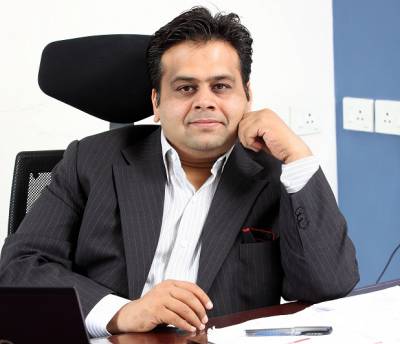AgTalk | Balancing fashion & comfort: Liberty's Anupam Bansal
With a production of more than 60,000 pairs a day, covering virtually every age group and income category, Liberty Shoes is the only Indian company amongst the top 5 manufacturers of leather footwear in the world. The company’s products are marketed across the globe through 150 distributors, 400 exclusive showrooms and over 6000 multi-brand outlets, and sold in thousands every day in more than 25 countries including fashion-driven, quality-obsessed nations like France, Italy, and Germany.
The company is a 50 year old enterprise with an annual turnover exceeding Rs 600 crores ($ 150 million). The factory is located in north India in Haryana and the shoe manufacturing is also done abroad. Adgully spoke about the brand’s current position, growth and business plans with Anupam Bansal, Executive Director of the Liberty Group.
An Economics graduate from Delhi's Shriram College of Commerce with a background in footwear designing from Ars Sutoria of Italy, Bansal has been associated with the company since 1994. He has occupied various positions in the marketing division prior to his present role in the company.
Following are the excerpts of the conversation with Anupam Bansal.
Adgully: Can you throw some light on the company’s growth till date?
Anupam Bansal: Liberty started way back as a footwear upper manufacturer for export market, we were not catering to the domestic market at all. We were primarily focused on USSR market. We began focusing on the Indian market from 1982 onwards. At that time Liberty had the most technologically advanced manufacturing facilities in India. In fact, we were the ones who were instrumental in bringing mechanised manufacturing into India. This took Liberty to market leadership during the whole of 80’s and 90’s. Every two years we applied new technologies to our products. Our products were our hero, Liberty as a brand was known for absolute fashion, comfort and durability and till date it’s know for the same. The expectations about our products are phenomenally high and we want the consumers to experience the brand.
AG: How Liberty has been affected by the changing trends over the years?
AB: From the year 2000, the new generation of consumers in the market has opened up and the expectations with the footwear market has increased drastically. Where we were known for durability and comfort, with the opening of new market Liberty moved with time and created different products to cater the increased demand in the scenario. Also people were willing to try new products. We tried to reach out to the consumers through our different product categories.
AG: How you see footwear industry developing today?
AB: The way we see the sector developing is in terms of market, popularity of the category at large and also looking at the consumption & potential for average selling price increase. Footwear is really an under-priced product in the Indian context; women buy footwear between Rs.500-600 range whereas today a single t-shirt cost more than it. Comparatively in the worldwide scenario a footwear brand is always expensive.
AG: Please share with us the kind of challenges Liberty as a part of footwear industry is facing?
AB: There are the same challenges that we used to face 20 years back as 85 per cent of the market is still unorganized. Comparing to Adidas, Reebok or Bata I feel their market share in whole would be less than 15 per cent. The organised retail is only 5 per cent and that is how companies handle their own retail market. Most of people in multi-brand market would like to sell their own label and they end up making money.
Taxation part is still a challenge for us as branded footwear companies are taxed 20-30 per cent more than local brands. Unorganized market gets better money from the consumer as compared to the organized market. But brands like us which have a national presence need to keep price constant and you need to give quality assurance too to your consumers which local guys never do.
AG: How according to you situation will be worked out?
AB: Local brands don’t have any MRP. They are not price governed and they change the price depending upon demand and supply. But today consumers are getting educated about the brand and what they want to buy, so there’s consumer pull that we are observing in the market. Consumer pull and retail pull make market work from government side as well as consumer’s side. 70 per cent people walk in local footwear shop than going and opting for branded footwear.
AG: What made you to change persona of the product and associate more with fashion and lifestyle?
AB: For me we are a consumer driven company so we have not changed but yes our consumers in India have changed. Their choices and buying patterns have changed. Any brand today needs to offer comfort &fashion to satisfy their consumers.
AG: How is competition from international brands coming into India affecting the Indian brands?
AB: It’s good because that is the time when people realise the brand value, like we have. About 10 years back we had to explain why we are expensive and our pitch used to convince them by what we were offering - a technologically driven fashionable product. Today brands have opened up the market and have taken price to a different level. Perception of quality has also been changed. All the brands coming in are developing the industry in certain way. Today the challenge is to shift consumers from unbranded to branded segment. India is a large market with diversified people and segments.
AG: What does the brand Liberty stand for and how strong is your market presence?
AB: Liberty as a brand is an affordable brand, a brand which provides balance between fashion and comfort. The Brand Liberty has received great response and out of 400 stores in 120 cities and towns, 325 are the franchise stores. Liberty is a fashionable and a known brand today.
AG: How has been the growth last year and what are your further plans for expansion?
AB: Last year was tough but as a brand even during recession we’ve not seen death. With every new store there is a growth opportunity but not beyond 5-7 per cent as expected. Location is the key to success, a success mantra for any retail business. We are planning to add 100 stores every year. We see a potential for 1000 Liberty stores in order to feel settled, but the capital required for this is high. We need to have a long term sustainable model for that.
AG: As you said you want to cater to the aspirations of an entire Indian household. But today youth is the focus area for almost all the brands so what are your plans in that direction?
AB: Youth is a very important segment we can’t leave that for sure; we are catering to them with a few of our brands. Also we are cautious about the fact that youth is very vulnerable about change. They are the most unloyal consumers for a brand. They need change and get attracted towards innovation. So we do not want to put all our expertise in that segment rather we want to cater to all the age groups looking at the fact that everybody today wants to be fashionable whether a 40 year old person or a 18 year old one.
AG: Share with us your marketing strategy?
AB: Marketing and promotional strategies and the selection of the medium is according to what best suits the brand. Can be television or print depending on the strategic requirement as per the product. There was a time when the focus was completely on television then it shifted to print and now we tend to move towards digital too. Our thought has always been to spend lower on advertising but simultaneously create an engaging and innovative product hence spending and creating more of store experience. In a year, including everything, we tend to spend 3 to 5 per cent of sales on advertising.
AG: Can you please share some insights on your association front?
AB: We’ve been associated with Femina Miss India and Lakme Fashion Week for six years.
AG: How you want to describe the current state of e-commerce market?
AB: On the growing e-commerce market I feel, yes the industry is growing rapidly and it is a great space to be in but what I feel is that it is taking away the impact of touch & feel. I want my consumers to feel the product. I would not want to fall in that medium completely since people are buying online and it’s becoming a fashion to shop from there as customers get huge discounts too.











Share
Facebook
YouTube
Tweet
Twitter
LinkedIn